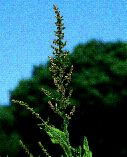|

Perennial plant belonging to the goosefoot family, growing to 50 cm/1.6 ft, with triangular leaves which are mealy when
young. Spikes of tiny greenish-yellow flowers appear above the leaves in midsummer. (Chenopodium bonus-henricus, family
Chenopodiaceae.)
Good King Henry
Chenopodium bonus-henricus
Height up to 50cm
Introduced, upright
perennial. Widely established and often common on disturbed arable land and wasteground. Lower leaves triangular; mealy when
young but then green. Stems sometimes with red lines. Leafless flower spikes appear MayAugust.
The leaves and seeds of all members of this genus are more or less edible. However, many of the species in this genus
contain saponins, though usually in quantities too small to do any harm. Although toxic, saponins are poorly absorbed by the
body and most pass straight through without any problem. They are also broken down to a large extent in the cooking process.
Saponins are found in many foods, such as some beans. Saponins are much more toxic to some creatures, such as fish, and hunting
tribes have traditionally put large quantities of them in streams, lakes etc in order to stupefy or kill the fish. The plants
also contain some oxalic acid, which in large quantities can lock up some of the nutrients in the food. However, even considering
this, they are very nutritious vegetables in reasonable quantities. Cooking the plants will reduce their content of oxalic
acid. People with a tendency to rheumatism, arthritis, gout, kidney stones or hyperacidity should take especial caution if
including this plant in their diet since it can aggravate their condition.
Range: Britain.
Habitat: Rich pastures, farmyards, roadsides.
|
 |
|

